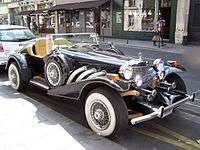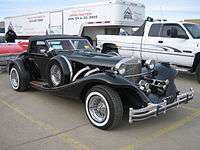Excalibur (automobile)
The Excalibur automobile was a car styled after the 1928 Mercedes-Benz SSK by Brooks Stevens for Studebaker. Stevens subsequently formed a company to manufacture and market the cars, which were conventional under their styling.[1]
A prototype premiered at car shows in 1963, fitted on a Studebaker chassis and using a 290-brake-horsepower (290 PS; 220 kW) Studebaker 289 V-8. Studebaker ceased engine production in December 1963 and transitioned all manufacturing to its Hamilton, Ontario plant, ending the availability of that engine.[2]
Stevens subsequently obtained engines from General Motors through his friends, GM executives Ed Cole and Semon "Bunkie" Knudsen. These were Chevrolet 327s in 300-brake-horsepower (300 PS; 220 kW) Corvette tune, making the 2,100-pound (950 kg) Excalibur a strong performer. With the standard 3.31:1 rear axle, acceleration from 0–60 mph (0–97 km/h) took less than six seconds.[3] Projected top speed was 134 mph (216 km/h).[4]
.jpg)

.jpg)

Over 3,500 Excalibur cars were built, all in Milwaukee, Wisconsin.[2] The American comedian Phyllis Diller was a notable proponent of the Excalibur automobile, and owned four of them.[5]
The company failed in 1986 but was revived several times.[6] Production of the Excalibur continued until 1990.[7]
See also
References
- "Brooks Stevens, 83, Giant in Industrial Design". The New York Times, John Holusha, January 7, 1995. January 7, 1995.
- "1964 Excalibur SS Pictures, History, Value, Research, News". Conceptcarz.com. Retrieved 15 May 2018.
- "How Excalibur Cars Work". How Stuff Works. 11 June 2007. Retrieved 15 May 2018.
- "1967 Excalibur Series I SS-SSK Roadster full range specs". Automobile-catalog.com. Retrieved 15 May 2018.
- "Excalibur History". Conceptcarz. Retrieved 15 May 2018.
- "Is Third Time The Charm For Excalibur?". Chicago Tribune. Retrieved 24 June 2020.
- "Camelot Classic Cars, Inc". Excaliburclassics.com. Retrieved 15 May 2018.
External links
| Wikimedia Commons has media related to Excalibur vehicles. |
- Preston, Alice. The Excalibur story.
- Site d'information sur l'automobile Excalibur (France)